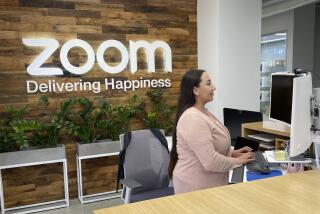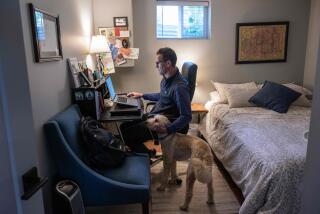It’s the Next Best Thing to Being There : Technology: Many businesses are saving on travel expenses by making use of the videoconference. It lets people in different cities hold meetings and demonstrate products.
BALTIMORE — When they absolutely, positively have to be there--but don’t want to pay travel costs--many businesses are opting for the next best thing: videoconferencing.
The technology allows people in different cities or cross-town offices to hold meetings, demonstrate products and hash out marketing plans. But unlike face-to-face encounters, videoconferencing does not require logistic gymnastics or the time and expense associated with traveling to another city.
And that, according to proponents of videoconferencing, is the beauty of the technology.
“With the recession and fuel costs being what they are, a lot of people are looking at this as a way to save money and air fare,” says Don Nipperd, who coordinates the public videoconferencing room owned by Maryland Casualty, a Baltimore-based insurance company.
The room is just one of 800 videoconferencing rooms that are connected to US Sprint’s Meeting Channel network in more than 27 countries, says Holly Owens, Meeting Channel director.
That includes a site in Moscow, where the first commercial videoconference--between students in Moscow and Minnesota--was held earlier this month.
The use of videoconferencing varies greatly, according to Owens.
Some California universities are beginning to offer degrees via videoconferencing. Lawyers use it to take depositions, a high-tech solution to the problem of trying to track down witnesses in faraway cities.
And federal agencies are looking at videoconferencing to ease communications between field offices and their customers.
That includes the Food and Drug Administration in Washington, whose resident experts must communicate often with pharmaceutical companies across the United States during the lengthy research and development phase of new drugs.
Meeting Channel services range from $90 an hour for domestic connections at slower transmission speeds to $650 an hour for high-speed connections.
At slower speeds, motions appear more jerky and images aren’t as sharp. High-speed transmissions are marked by superior clarity and little discernible delay in movement.
In all cases, the equipment is pretty much the same: meeting rooms have special cameras, microphones and a device that breaks an image down and sends it to another site. At the receiving end, the image is reassembled.
The Meeting Channel can set up a videoconference connection on 30 minutes’ advance notice, Owens says.
For international communications, where phone connections can be tricky, 48 hours’ notice is required.
Although current technology requires customers to buy videoconference equipment or use a provider like Meeting Channel, that soon won’t be necessary.
Videoconferencing is coming to the desktop computer, a trend that will make the high-tech service affordable and available to virtually every personal computer user, says Jon Merril, vice president of High Techsplanations Inc., a Bethesda, Md.-based consultant.






